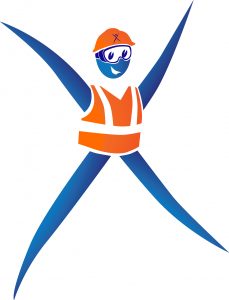 Who’s in the Hot Seat?
Who’s in the Hot Seat?
Lots of people are exposed to heat on the job, either outdoors or in hot indoor environments. Factors like high air temperatures, radiant heat sources, high humidity, direct physical contact with hot objects, or strenuous physical activities can contribute to heat-related illness. If it’s both hot and humid, the risk increases, especially when doing heavy work tasks or using bulky or non-breathable protective clothing. Those working outdoors in hot weather and direct sun (doing construction, farm work, oil and gas line operations, asbestos removal, landscaping, emergency response operations, and hazardous waste site activities, for example) are at a higher risk of heat-related illness. Plus, some workers might be at greater risk if they have not built up a tolerance (acclimatized) to hot conditions, or if they have certain health conditions.
How Does Heat Affect Workers?
When a person works in a hot environment, their body must get rid of excess heat. It does this mainly by circulating blood to the skin and sweating. When the air temperature is warmer than our normal body temperature, cooling the body becomes more difficult. Sweating is effective only if the humidity level is low enough to allow evaporation, and if the fluids and salts that are lost are adequately replaced. If the body can’t get rid of excess heat, its core temperature rises and heart rate increases. As the body continues to store heat, the person begins to lose concentration and has difficulty focusing on a task, may become irritable or sick, and often loses the desire to drink. The next stage is most often fainting and even death if the person isn’t cooled down.
Excessive exposure to heat can cause a range of heat-related illnesses, from heat rash and heat cramps to heat exhaustion and heat stroke. Heat stroke can result in death and requires immediate medical attention. Exposure to heat can also increase the risk of injuries because of sweaty palms, fogged-up safety glasses, dizziness, and burns from hot surfaces or steam.
What’s the Heat Index?
The “heat index” is a single value that accounts for both temperature and humidity. The greater the heat index, the hotter the weather feels, since sweat does not readily evaporate and cool the skin. The heat index is a better measure than air temperature alone for estimating the risk to workers from environmental heat sources. The following table shows the risk level at certain temperatures and protective measures to take to minimize the risk:
| Heat Index | Risk Level | Protective Measures |
| Less than 910F | Lower (Caution) | Basic heat safety and planning |
| 910F to 1030F | Moderate | Implement precautions and heighten awareness |
| 1030F to 1150F | High | Additional precautions to protect workers |
| Greater than 1150F | Very High to Extreme | Triggers even more aggressive protective measures |
The heat index risk levels are broken down by the following recommended precautions:
- Lower (Caution)—Most people can work safely when the heat index is less than 910F; only basic measures are required, including providing adequate amounts of drinking water and ensuring that adequate medical services are available.
- Moderate Caution—Some additional precautions are necessary to prevent heat-related illness. Review heat-related illness signs and precautions with workers. Remind workers to drink adequate water. Provide workers opportunities to rest in cool, shaded areas. Be aware of conditions that could increase risk.
- High Caution—Increase rest periods and designate a knowledgeable person (well-informed on heat-related illness) at the worksite to determine appropriate work/rest schedules. Reduce work load and pace strenuous work tasks. Remind workers to drink plenty of water every 15 to 20 minutes.
- Very High to Extreme Caution—Reschedule nonessential work activities and move essential work tasks to a time during the work shift when the heat index is lower. If this isn’t possible, establish a water drinking schedule, enforce work/rest schedules, and be extra vigilant in monitoring workers for heat-related illness symptoms, including using physiological monitoring and systems for effective communications. A knowledgeable person on site who can assess heat-related safety concerns is required.
How Do I Keep My Cool?
To protect yourself from heat stress, try the following:
- Drink plenty of water—8 ounces every hour if actively sweating. Staying hydrated is essential when working in hot environments;
- Take plenty of rest breaks in a cool, shady spot with fans, when possible;
- Wear light-colored cotton clothing;
- Do the heaviest work during the coolest time of the day (early mornings before the heat index rises); and
- Check your temperature and heart rate often to make sure that you are not having adverse effects from the heat.
Can I Get a Recap?
The best way to prevent heat stress is to plan. Remember these tips when it comes to working in the heat and controlling heat stress:
- Take it seriously—heat exposure is a serious hazard, and it affects people differently. Employees who aren’t used to the heat and who have health complications are at a much greater risk.
- Know the signs—be familiar with the symptoms of heat stress and respond immediately.
- Get friendly with the heat index—it will help you know what additional protections you need to put in place for the day’s temperature and humidity.
- Look out for yourself—when you’re working in the heat, don’t wait for others to protect you. Review the tips for keeping yourself cool and then follow them!
- Plan for emergencies and know what to do—acting quickly can save lives!
